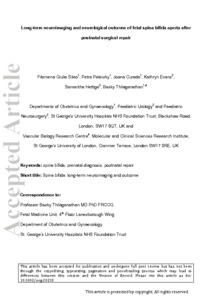Sileo, FG; Pateisky, P; Curado, J; Evans, K; Hettige, S; Thilaganathan, B
(2019)
Long-term neuroimaging and neurological outcome of fetal spina bifida aperta after postnatal surgical repair.
Ultrasound Obstet Gynecol, 53 (3).
pp. 309-313.
ISSN 1469-0705
https://doi.org/10.1002/uog.20215
SGUL Authors: Thilaganathan, Baskaran
![[img]](https://openaccess.sgul.ac.uk/110570/1.hassmallThumbnailVersion/Sileo_et_al-2019-Ultrasound_in_Obstetrics_.pdf)  Preview |
|
PDF
Accepted Version
Available under License ["licenses_description_publisher" not defined].
Download (287kB)
| Preview
|
Abstract
BACKGROUND: Parents faced with the choice between postnatal management versus prenatal surgery for spina bifida need to have up-to-date information on outcomes. The aim of this study is to report the long-term physical and neurological outcomes prenatally diagnosed spina bifida managed by a multidisciplinary team from a large tertiary centre. METHODS: A retrospective cohort study of all cases fetal spina bifida managed in a tertiary unit between October 1999 and January 2018. All cases of fetal spina bifida from the local health region were routinely referred to the tertiary unit for further perinatal management. Details on surgical procedures and neonatal neurological outcomes were obtained from institutional case records. RESULTS: During the study period, 241 fetuses with isolated spina bifida were seen in the unit, with 84 (34.9%) women opting to continue with the pregnancy after counselling by multidisciplinary clinicians. After birth, hind brain herniation was observed in 91.5% with only 7 infants requiring surgical decompression. Ventriculo-peritoneal shunt insertion was needed in 64.2% of infants who demonstrated normal or mild cognitive impairment in 85.4% of cases at a mean age of 8yrs. Cumulatively, 40% of infants were walking independently or using minor support and reported normal or mild impairment of bladder or bowel function in 45.4% and 44.5% of infants, respectively. CONCLUSIONS: Neurodevelopmental and neurological outcomes between prenatal versus postnatal repair are similar. As with fetal surgery, conventional postnatal surgery is associated with the reversal of hind brain herniation. Similarly, postnatal ventriculoperitoneal shunts appear to be mainly required in fetuses without evidence of significant fetal ventriculomegaly. This article is protected by copyright. All rights reserved.
| Item Type: |
Article
|
| Additional Information: |
This is the peer reviewed version of the following article: Sileo, F. G., Pateisky, P. , Curado, J. , Evans, K. , Hettige, S. and Thilaganathan, B. (2019), Long‐term neuroimaging and neurological outcome of fetal spina bifida aperta after postnatal surgical repair. Ultrasound Obstet Gynecol, 53: 309-313, which has been published in final form at https://doi.org/10.1002/uog.20215. This article may be used for non-commercial purposes in accordance with Wiley Terms and Conditions for Use of Self-Archived Versions. |
| Keywords: |
postnatal repair, prenatal diagnosis, spina bifida, 1114 Paediatrics And Reproductive Medicine, Obstetrics & Reproductive Medicine |
| SGUL Research Institute / Research Centre: |
Academic Structure > Molecular and Clinical Sciences Research Institute (MCS) |
| Journal or Publication Title: |
Ultrasound Obstet Gynecol |
| ISSN: |
1469-0705 |
| Language: |
eng |
| Dates: |
| Date | Event |
|---|
| 5 March 2019 | Published | | 6 February 2019 | Published Online | | 9 January 2019 | Accepted |
|
| Publisher License: |
Publisher's own licence |
| PubMed ID: |
30663167 |
 |
Go to PubMed abstract |
| URI: |
https://openaccess.sgul.ac.uk/id/eprint/110570 |
| Publisher's version: |
https://doi.org/10.1002/uog.20215 |
Statistics
Item downloaded times since 25 Jan 2019.
Actions (login required)
 |
Edit Item |



